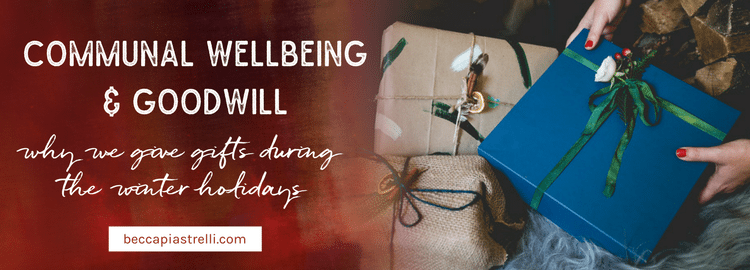
We’re getting to that time of year where they are starting stringing lights on the large redwood trees in the downtown plaza of my town, the ladies who own a local pie business are sampling bourbon pecan and gluten-free pumpkin at our local coffee shop, and pink metallic holiday trees are popping up in our local drugstore.
Your reaction to this fleeting moment that comes right before the holiday boom could be one of a number of things.
You could be fist pumping the air right now, red coffee cup in hand, and queuing up Love Actually on your streaming service like…yesterday.
…or you could be plugging your ears and covering your eyes because you’ve had it up to *here* with the insane consumerist mania that bewitches society every November and December.
…or you could be taking it moment by moment—enjoying the crisp descent of the season, planning your gratitude meal for next week’s gatherings, and beginning to think about how you want to approach these final weeks of the calendar year.
Whatever’s happening in your system right now, know that I honor it. This time of year can bring up a lot of intense emotions and anxiety, in addition to the joy and excitement.
I’ve found that a lot of the intense emotions associated with this time of year have to do with the tradition of exchanging gifts.
No matter your religious affiliation or stance on the winter holidays, gift giving is a well-woven custom in our culture.
And, as someone who has had both the experience of being super obsessed with giving and receiving a lot of presents and also being totally fed up with the over consumerist, environmentally destructive, and financially irresponsible nature of what how we’re told to do holiday gift giving, it’s been very helpful to connect with the origins of this long-held custom and remember how our ancestors approached it.
Much of pre-Christian written history points to the Roman Feast of Saturnalia as being the origin of gift giving during the time of the winter solstice. Saturnalia was a seven-day feast marking the winter sowing season in Italy. Work was suspended and there was dancing in the streets for an entire week. These festive days were marked with the giving of gifts of candles and wax statuettes and showing generosity to the city’s poor.
But these traditions weren’t isolated to Rome, alone. (That’s the problem with written history—it rarely paints the whole picture and is often written by the settler rather than the settled.)
This concept of stopping work to honor the darkest time of year (the winter solstice) and celebrate with your community has roots in cultures all over Europe and much of the rest of the world. I can only speak from the perspective of my own lineage—as a woman of European descent who has done research and worked with my ancestral origins of Old Europe.
Take yourself back to a time when electricity and central heating wasn’t a thing, and pastoral living meant you were deeply connected to the rhythms and cycles of the land.
Winter was a time when life was harder. It was cold and dark and surviving until spring was the highest priority for your family and community at large.
It was from that place of cold winter darkness that giving gifts was truly an act of goodwill for your community.
It was an opportunity to ensure your neighbor thrives through the winter season, so gifts would be items like candles to ensure they had enough light, extra wool or knit items of clothing to keep them warm, food that you grew an abundance of during harvest to help fill their pantry, wood to burn in their hearth fire, or folk medicines and remedies to keep them healthy and avoid sickness.
The root of winter holiday gift-giving truly is caring for the wellbeing of your neighbor.
It’s not expectation based. It’s not about propping up the retail industry of the economy in their fourth quarter financials. It’s not about having the latest Lexus or smartphone.
It’s saying to a loved one, “I want you to thrive through a time when it’s traditionally harder to thrive.”
So, I ask you this…
How can your re-frame gift giving so that it feels positive, intentional, and from your heart this winter solstice season?
Does it mean giving money (or your time) to organizations that are making a big impact on your community and causes that really fire you up?
Does it mean cooking an extra holiday meal for a family going through a hard time right now?
…or does it mean doing gifts a little differently this year and making them with your hands —infusing your love and good intentions for those you cherish most into every drop of oil, twist of twine, and sprinkle of lavender buds?
Whatever it is, I hope you can take these next few weeks of autumn and winter magic to cultivate more meaning and magic into your gift giving practice. I promise it’s so much more fulfilling than a stocking filled with gizmos from the dollar bin at Target.
I’d love to know what you are desiring to do for gifts this holiday season. Leave a comment below and let’s chat more about it.